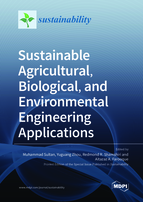Sustainable Agricultural, Biological, and Environmental Engineering Applications
A special issue of Sustainability (ISSN 2071-1050). This special issue belongs to the section "Sustainable Agriculture".
Deadline for manuscript submissions: closed (30 September 2021) | Viewed by 86903
Special Issue Editors
Interests: developing energy efficient heat- and/or water-driven temperature and humidity control systems for agricultural storage; greenhouse; livestock; poultry applications
Special Issues, Collections and Topics in MDPI journals
Interests: physical and chemical properties of agricultural feedstock; thermal conversion, gasification, and pyrolysis of biomass; clean combustion, emission monitoring, and pollutant control for household cooking/heating; bioenergy equipment development; green conversion of biomass; agricultural product processing engineering
Special Issues, Collections and Topics in MDPI journals
Interests: precision agriculture; wireless sensors; IoT; digital agriculture; system analysis and control; agricultural modeling and simulation; agricultural robotics; greenhouse automation
Special Issues, Collections and Topics in MDPI journals
Interests: precision agriculture; sensing and control systems; deep learning; variable rate technologies; environmental sustainability
Special Issues, Collections and Topics in MDPI journals
Special Issue Information
Dear Colleagues,
Sustainable development in the agriculture sector is crucial to achieve the 2030 Sustainable Development Goals (SDGs) set by the United Nations (UN). There are lots of challenges to develop modern and intelligent agricultural techniques, tools, and systems, by which sustainable agriculture and food security can be satisfied. In addition, carbon neutral development and clean energy utilization are also associated with the UN-SDGs. Such agricultural, biological, and environmental engineering studies are the need of ghd 21st century, particularly from the viewpoint of the agricultural water–energy–food security nexus. The recent proliferation and technological advancement in these engineering applications are the focus of this Special Issue.
This issue aims to share quality research concerning agricultural, biological, and environmental engineering, and the application of these engineering techniques in the agriculture sector. This Special Issue includes (but is not limited to) engineering technologies and applications related to farm energy and power, farm mechanization, irrigation and drainage, precision agriculture, food processing and storage, livestock and poultry sheds, safe utilization of coal and biomass/biogas, wastewater treatment, etc.
Prof. Dr. Muhammad Sultan
Prof. Dr. Yuguang Zhou
Dr. Redmond R. Shamshiri
Prof. Dr. Aitazaz A. Farooque
Guest Editors
Manuscript Submission Information
Manuscripts should be submitted online at www.mdpi.com by registering and logging in to this website. Once you are registered, click here to go to the submission form. Manuscripts can be submitted until the deadline. All submissions that pass pre-check are peer-reviewed. Accepted papers will be published continuously in the journal (as soon as accepted) and will be listed together on the special issue website. Research articles, review articles as well as short communications are invited. For planned papers, a title and short abstract (about 100 words) can be sent to the Editorial Office for announcement on this website.
Submitted manuscripts should not have been published previously, nor be under consideration for publication elsewhere (except conference proceedings papers). All manuscripts are thoroughly refereed through a single-blind peer-review process. A guide for authors and other relevant information for submission of manuscripts is available on the Instructions for Authors page. Sustainability is an international peer-reviewed open access semimonthly journal published by MDPI.
Please visit the Instructions for Authors page before submitting a manuscript. The Article Processing Charge (APC) for publication in this open access journal is 2400 CHF (Swiss Francs). Submitted papers should be well formatted and use good English. Authors may use MDPI's English editing service prior to publication or during author revisions.
Keywords
- Sustainable agriculture
- Food security
- Robotics and farm mechanization
- Biomass, biogas, and bioenergy
- Temperature and humidity control systems for agriculture
- Sustainable agricultural technologies
- Renewable energy and agriculture
- Water and wastewater treatment









